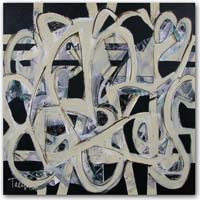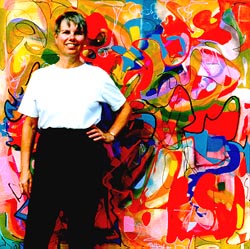
Lynne with TOKYO FANTASY
My Life as an Artist
by Lynne Taetzsch
I grew up in Newark, New Jersey until we moved to Irvington when I was in the third grade. From the time I can remember I was always making some kind of art, from sculpting homemade play dough to holiday decorations and craft projects. When I was old enough to get a small allowance, I spent it all on art supplies.
As a child I was happy to copy, to coordinate my hand and eye, and to achieve technical mastery of my tools. There was a joy of craft, of handling paint and chalk, paper and brush. In my early teens I did a lot of drawing from nature, delighting in the intimacy gained through such close looking at a subject.
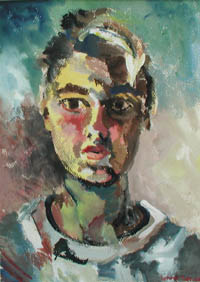 SELF PORTRAIT, watercolor on paper
SELF PORTRAIT, watercolor on paper
A couple years later I'd become alienated and depressed, writing poems like "Five drops of blood smearing her pretty face, formed a pattern of delicate lace." At this time I drew and painted a lot of portraits, making everyone in my family sit for me. They often complained that I accentuated their worst features, yet I felt justified considering that I was no less cruel to myself. I would look in a mirror as I painted, posing with my mouth open screaming in one. In another, I painted a face split down the middle, orange-reds in one half, blue-greens in the other.
From my quietly depressed early teens, I moved into my wild stage. I rode a wave from mania to depression, doing everything I could to stimulate the mania. Bored by high school, I quit after my junior year and got my G.E.D. in the summer.
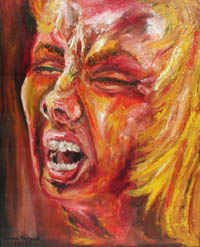 LYNNE SCREAMING, oil on board, 1959
LYNNE SCREAMING, oil on board, 1959
That fall I started Rutgers University in Newark where I took a drawing class. We stood at easels and drew with Conte crayon and charcoal on large newsprint pads, imitating the styles of Matisse, Picasso, and others. This class helped me to loosen up--to use the larger gesture of my whole arm instead of the tight strokes of cramped fingers. And I continued painting on my own, developing a looser style which was much more expressive in terms of color and form.
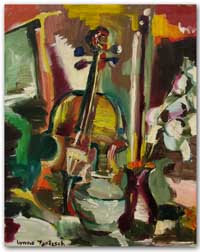 LEONARD'S VIOLIN, oil on board, 1960
LEONARD'S VIOLIN, oil on board, 1960
By the time I got to the University of Southern California on a scholarship the following year, I had lost interest in fondling objects with my eyes in order to represent them. It was the surface of the painting itself that I fell in love with, the flat two-dimensionality, play of planes, intricacies of texture and subtleties of tone. My professor at USC asked, "Where did you learn to paint like that?"
I liked the freedom of being 3,000 miles from home, and bleached my hair to match the bright California sun. But I found dorm life at USC constricting in odd ways. Women were required to wear a dress or skirt to dinner, for example, even if it was wrinkled and filthy, rather than a clean pair of slacks. It was almost worth it, though, to eat the sweet honeydew melons I'd never tasted in New Jersey.
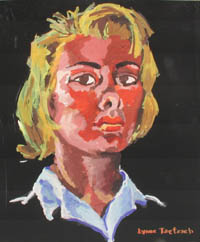 LYNNE AT USC, poster paint on board, 1961
LYNNE AT USC, poster paint on board, 1961
USC had too many rules, so I applied to Cooper Union art school in New York City. Now this was my kind of place. Sloppy t-shirts and jeans were the norm, and just about everyone there was acting up or acting out.
We would take speed and drink coffee, talking each other to death. We would build light and sound machines, projects we set on fire, constructions to tickle the senses. We would wander around Washington Square, sketching the men playing chess or sleeping on benches. We would spend days walking uptown, checking out the galleries and museums. My vision was changed forever by New York's action painters, the abstract expressionists Jackson Pollock, Willem de Kooning, Hans Hoffman, Helen Frankenthaler, Fanz Kline, Robert Motherwell, and Mark Rothko.
At that time the popular notion of a serious artist was likely to be an alienated, unshaven, drink-and-drug- driven rebel who trampled on tradition, howled at the absurdity of life, and looked down contemptibly on middle-class values and low-brow culture. I identified with this male icon of the beat generation, and strove to excise myself from any identification with mainstream morality, values, and institutions. I wore black, drove a motorcycle, and let the dust balls accumulate in my pad.
My favorite painting colors were red and black. No one would call my paintings decorative or pretty. I took it as a compliment when someone said, "You paint like a man."
At Cooper Union classes were three to six hours each instead of the fifty minutes a typical college class lasts. This gave students an opportunity to immerse themselves in their projects, and gave the teachers plenty of time to follow through with each student. I had classes in calligraphy, architectonics, one and two dimensional design, life drawing, and painting.
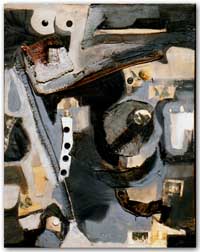 FAMILY PORTRAIT, collage & oil, 1962
FAMILY PORTRAIT, collage & oil, 1962
The real find for me at Cooper Union was my painting teacher, Charles Seide. He helped me get to a point where I knew what I was about and no longer needed art school. In his class I added collage materials to the oil paint and that process intensified my sense of composition, leading my art to its non-objective stage. All art is abstract in the sense that it moves away from "reality" to some degree. Non-objective art, however, does not begin with the world at all. It has no reference point.
When I left Cooper Union, I had my first solo show (we called them "one man" shows in those days) at Paula Insel Gallery. I basked in glory when my friends and teachers came to the opening.
Since then my life has taken a lot of turns. I've bounced back and forth from the east to the west coasts several times, lived in Florida, California, New Jersey, Virginia, Kentucky, and now in the beautiful Finger Lakes region of New York State. I've worked as a secretary, a writer, an editor, a publisher, a junior-high English and Math teacher (six months), a business trainer and manager, a Kirby vacuum cleaner salesperson (one week), a leather crafter, and a college professor. Through most of it, I kept painting, and since 2000 I've been painting full time in my studio in Ithaca, New York.
I painted "Sun Rising" when I lived in Irvington, New Jersey in the early seventies:
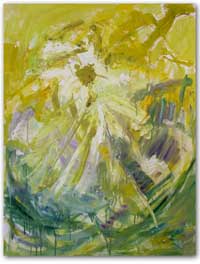 SUN RISING, oil on canvas, 1972
SUN RISING, oil on canvas, 1972
In the early 1980s I lived in southern Florida, and found that it took forever for oil paint to dry. Here's one of the last ones I painted in oils:
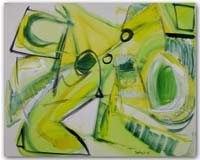 IMPROVISATION, oil on canvas, 1985
IMPROVISATION, oil on canvas, 1985
In the eighties I switched from oil paint to acrylics. I found that acrylics worked better for me because they dry quickly. I work on a painting over many days, adding layers that accumulate without totally eradicating the previous layers. The process or action of the painting allows me to express my intentions through the motion of the brush or palette knife. Like jazz, the heart of my art is improvisation.
Here's one of my favorites from San Diego, where I lived for a few years in the eighties:
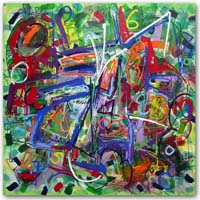 123456, acrylic on canvas, 1987
123456, acrylic on canvas, 1987
The painting "X-Oh" won the first place prize at the Foothills Festival of the Arts, a juried show in La Mesa, California in 1989.
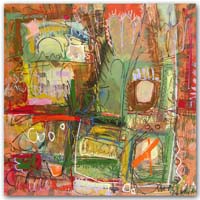 X-OH, acrylic on canvas, 1988
X-OH, acrylic on canvas, 1988
In graduate school at Florida State University in the 90s, I made a presentation on the New York school of action painters from the 50s and felt that I should take a feminist stand. I searched for the few books on the women of this period and planned to present their works to the class as if the whole school of action painting consisted of these women only. I was going to leave out the men in order to make a statement about the way women have consistently been left out of art history.
But I couldn't do it. While I found Joan Mitchell's surfaces absolutely gorgeous, I had never known her work during my formative years as an art student. It was the male artists--Pollack, deKooning, Motherwell, Rothko--whose work had influenced me. I couldn't leave them out to make a political statement. Their art spoke to me then. It speaks to me still.
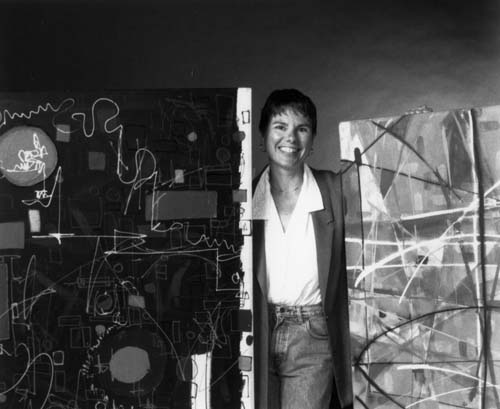
Since Cooper Union I've shown my paintings in solo, group, and juried exhibitions throughout the United States. See my resume for details.
In the summer of 2005 we had a house and studio built in Ithaca. Here's a photo of the studio:
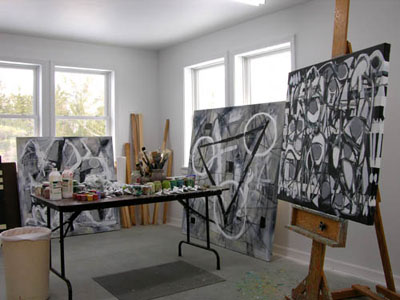
The windows on the left face North, which provides the best light for painting. South light gives too much glare. The other windows face the back of our lot, which is bordered by a brook. It's a lovely environment to work in.

See more art.
 ABSTRACT ART by Taetzsch: Contemporary Modern Paintings, Prints & Drawings
ABSTRACT ART by Taetzsch: Contemporary Modern Paintings, Prints & Drawings 












